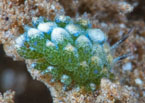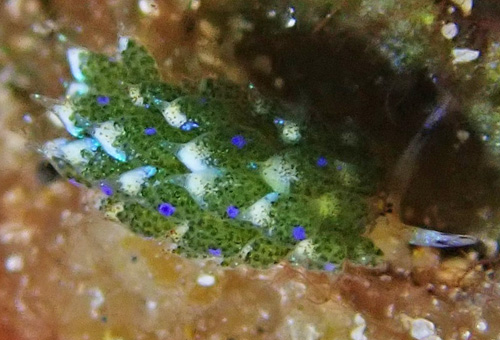| Home |
| Acknowledgments |
| Conventions |
| Glossary |
| Maps |
| References |
| Links |
| Articles |
| Thumbnails |
| Species
list |
| Family |
| Next
species |
Additional Photos

head pattern

white granules

blue patches

less blue

side

young

pair

Costasiella sp. #3

| Maximum size: 4 mm. Identification: This species has a translucent-cream body decorated with iridescent flecks. There is a complex black patch behind the eye spots that surrounds a rust-brown spot and has branches extending onto the sides of the head and onto the bases of the rhinophores. An iridescent blue patch is located between the two branches on each side of the head. The front of the head is variably flecked with rust-brown and there are three short, off-set black lines on the distal third of each rhinophore. Very young animals have a single black line extending the whole length of the rhinophore. The cerata contain dense green granules and iridescent flecks. However, the central cerata have white granules in their distal portions. (Note 1) The lateral cerata often have small, rust-brown subapical spots and the central cerata usually have intensely blue patches on their outer faces. (Note 2) There are a few widely spaced brown flecks on the apexes of the central cerata. Natural history: Prior to 2020/2021, Costasiella sp. #3 was known from only two animals found at 1-2 m (3-6 ft) on an exposed to moderately exposed accretion platform. Recently, however, numerous animals were found at 15 m (49 ft) on Avrainvillea erecta (in association with Costasiella kuroshimae and/or Costasiella fridae). (see photos) It's diurnally active and readily autotomizes its central cerata. Distribution: Oahu: also known from Kwajalein Atoll and Japan. Taxonomic notes: It was first recorded in Hawaii from Diamond Head State Park, Oahu by CP on Oct. 3, 1999. Since its food algae, Avrainvillea erecta, is thought to be introduced there's some chance that this species is, as well. However, it's also possible that it's an indigenous species that originally ate something else but found A. erecta to its liking once it was introduced. (Note 3) Photo: Roney Rodrigues: west shore, Oahu; March 7, 2021. Observations and comments: Note 1: The white granules appear to be outpocketings of the digestive gland that lack stored chloroplasts. Several other sacoglossids that readily autotomize their central cerata also concentrate chloroplast storage in their lateral cerata (that aren't shed). Presumably, this reduces the cost of autotomization. Note 2: The intensely blue patches on the cerata appear to be irregular, subcutaneous masses (in close-ups) and show little variation in appearance with changes in the apparent angle of the light. That suggests that they may be composed of an intrinsically blue (or fluorescent?) pigment rather than being the result of iridescence. The bright blue spots may bring the species into the "periphery" of the mimicry complex associated with the ocellate sea hares. Or, perhaps the color is incidental and the masses contain toxins evolved to deter predators after autotomization? Note 3: The original two animals from 1999 weren't found in a typical Avrainvillea erecta habitat. Meanwhile, one animal from elsewhere that appears to be a close match (under the assumption that it had autotomized its central cerata before being photographed) was found on Codium sp. at Kwajalein Atoll. |
| Thumbnails |
Species
list |
Family | Next species | Top |